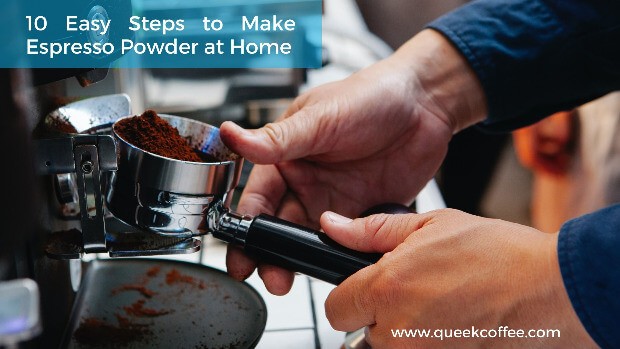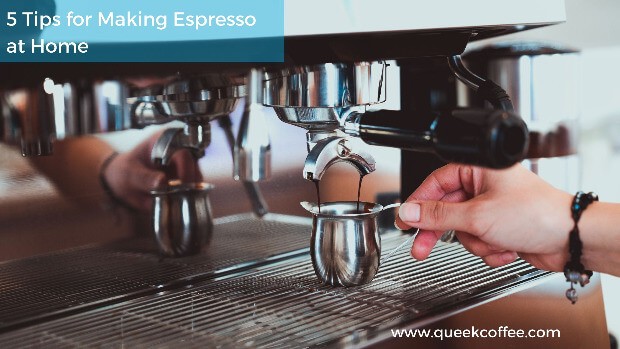Last updated on March 26th, 2023 at 06:10 pm
As coffee enthusiasts know, espresso can add incredible flavor to your coffee without adding tons of calories or sugar, and it makes the best base for a creamy latte or cappuccino you’ll ever taste. Since espresso powder is typically used to make espresso, most people think they need to go to their local specialty coffee shop to get some delicious espresso powder.
But this couldn’t be further from the truth! Espresso powder can be made at home with just three simple ingredients and 10 minutes of work!
Step 1 – Gather your Ingredients
To make espresso powder, you’ll need a few basic ingredients: – Instant Coffee: Any instant coffee will do. – Granulated Sugar: White granulated sugar is best for flavoring. You can also experiment with other sweeteners like honey, corn syrup, or even coconut sugar. – Vanilla Extract: Adding vanilla extract helps bring out some of the nuances in coffee flavor and gives your powder a great aroma. It’s not required, but it is recommended!
Step 2 – Grind Your Beans
The most crucial step in making espresso powder is grinding your beans. You’ll want an excellent grind for your grounds; otherwise, you’ll have a hard time dissolving it into hot water. If you don’t have an espresso grinder, you can use a regular coffee grinder to do it.
Just be sure not to go too far and turn your beans into dust! Some people suggest heating your coffee before grinding; that will help open up its pores so more of its flavor can come out during grinding.
Be aware that if you heat whole beans for too long, they can lose their oils and become stale quicker than usual! So be cautious about how long and often you heat them.
Step 3 – Get Perfectly Ground Coffee
Step 3 is easy. You only need fresh whole coffee beans, a grinder, and a sieve. It’s best to use organic coffee beans to make espresso powder. Grind your coffee beans into acceptable grounds using your grinder.
The more acceptable ground, the better so that more of their flavor comes out in your espresso powder (it also makes it easier to drink without adding milk or sugar).
Once you have ground up all of your coffee, go ahead and put it through a sieve (or tamis cloth) so that any small pieces are removed from it, as they won’t help flavor your espresso powder much, if at all.
Step 4 – Brew the Coffee
In a coffee grinder, coarsely grind your coffee beans. Please place them in a medium bowl and add 1/2 teaspoon of espresso powder for every three tablespoons of beans. Mix with a wooden spoon until thoroughly combined, then place in an airtight container.
If you don’t have an espresso maker on hand (yet), you can brew these grounds straight up with boiling water in a French press or similar device.
Step 5 – Let it sit in a container overnight
After brewing a pot of coffee, let it sit in a container overnight. The grounds will settle and separate from all of their oils, leaving you with just what you need for your espresso powder. Plus, since all of those oils aren’t there anymore, your espresso powder won’t go bad or mold as quickly.
You can use it immediately or store it in an airtight container (or a Mason jar) until you are ready to use it! I typically make a batch every 2-3 weeks and only need about three tablespoons each time! I’m still working on getting my quantities right so I don’t wind up with more than we can use!
Step 6 – Pour out the Extra Coffee Liquid
After allowing it to drip, pour out any excess liquid that remains in your portafilter. You should be left with a coarse espresso powder and a clean portafilter.
This leftover liquid is called crema and can make your coffee bitter if you don’t get rid of it. The crema doesn’t add anything positive or tasty; it’s mostly just water, so don’t fret if you dump some down the drain.
Step 7 – Add Flavoring and Sweetener (optional)
Mix in your sweetener and flavoring if desired. You can use vanilla extract or other extracts (almond is my favorite), chocolate syrup, cinnamon, Nutella, etc.
These will all add calories – so make sure you keep track! 🙂 If you like delightful drinks, use a zero-calorie sweetener like stevia or erythritol instead of adding sugar. For example, 1/2 tsp stevia = 3 calories; 1/2 tsp erythritol = 0 calories.
Step 8 – Store your espresso in an airtight container
Store your espresso in an airtight container. Once it is ground, your espresso powder should be stored in an airtight container away from moisture and light until it is ready to be used. If you choose to use a large coffee canister or bucket, seal off one end so that no oxygen can come into contact with your freshly ground coffee beans.
Vacuum-sealable bags are great for smaller batches of coffee powder because they help maintain freshness without taking up too much space in your kitchen.
Step 9 – Use your homemade espresso as desired!
You can either add a scoop of homemade espresso powder to some hot water or drink it on its own. If you’re using your homemade espresso as an instant coffee replacement, mix two tablespoons of cocoa powder with one tablespoon of sugar and then add hot water.
Enjoy! Not only will you save money with your homemade espresso, but you’ll also feel good knowing that no animals were harmed in its making. And if that doesn’t make you happy, I don’t know what will!
Step 10 – Enjoy
Finally, enjoy your delicious homemade espresso powder. Store in an airtight container in a cool, dry place and use as you would store-bought espresso powder. One pound will be good for approximately 40 batches of coffee or about one month of enjoyment for a heavy user (such as me). Enjoy! You’re done! Cheers!
Making your espresso powder is surprisingly easy and doesn’t take more than 10 minutes of your time. Try out these steps to make espresso powder for yourself! Also, it allows you to taste freshly-ground coffee beans without having an expensive machine at home.

MD Azizul Hakim is a content creator and the co-founder of Queek Coffee. He has been writing content and reviews for many years and loves to brew coffee and serve it to his colleagues.





